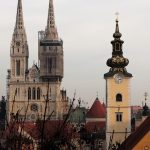April 19, 2020 — Within days after Italy’s country-wide coronavirus lockdown, a few of the country’s boat owners sailed for Croatia’s coast to avoid the infection in their own country. They arrived in marinas, on island harbors and spent a week galavanting around Zadar’s archipelago while local police responded to reports of unregistered foreigners. Some even escaped via ferry to their weekend homes off the Croatian coast, before the government prohibited non-residents from going to islands.
Those days appear to be over. For now.
The early trickle of new arrivals did not become a flood, according to the head of Zadar’s Civil Protection Directorate, Šime Vicković. In fact, the number of new arrivals — nautical or otherwise — has fallen close to zero, he told Zadarski List.
The problems first began with boats sailing under Italian flags arriving at Dugi Otok in the first half of March, in some cases overnighting in the Telascica Nature Park before locals reported them to police.
Tensions grew as several Italians and Slovenes took up residence in summer homes on the Dugi Otok. Neighboring islands reported a similar influx of locals during the early stages of Croatia’s coronavirus response. Their compatriots did not follow them.
“All these reports are controlled by the Maritime Police, and our headquarters had a report on boaters coming to Sali, but since then we have no more reports,” Vicković told Zadarski. “Those who have entered our waters are monitored by the police, warning them that they are obliged to check in if they remain here in their property and, of course, to go into self-isolation.”
Croatia’s islanders, or boduli, expressed dismay over the unexpected arrivals. Many were not registering with Croatia’s eVisitor system, living off the radar of authorities and giving a rosier picture of the state of the islands.
Locals also worried about their population, which skews towards pensioners and those most susceptible to the virus.
The situation is, however, much different now, especially since the number of those infected is in a slight decline. The national Civil Protection Directorate’s decision to prevent non-residents from traveling to islands prevented Croats, Slovenes and Italians fleeing to their vacation homes. The move may have prevented outbreaks on islands.
The president of the Croatian Islands Association, Denis Baric, appealed to the authorities to continue to protect islanders as the government mulls loosening restrictions.
“Following the situation, we must appeal to the competent authorities to do everything possible to protect our islanders, who, due to their age, are the largest crisis group,” he wrote in a statement. “We are aware that every day that business owners do not work has a direct impact on their survival, and presents a direct threat to their employees. We are all anxious today for our future existence, but we are determined that we will put the life and health of every individual first.”
For now, only persons residing on the islands are allowed to purchase ferry tickets to go to islands, as well as those with ePasses. The latter has become a point of contention for some, as newer faces with tenuous connections to islands show up.
Barić said the islands had a strong network to help the elderly, benefiting from the sort of small-town environment where everyone knows everyone. The Islander association said allowing non-residents to migrate to islands at this moment is akin to allowing COVID-19 to spread on Croatia’s islands.
The perception of a Croatian island as an oasis against COVID-19 remains true, with the exception of Murter. Infections along the Adriatic remain relatively low, compared to larger urban centers.
“We cannot help but look back and urge the authorities to do everything possible to protect our islanders, who are the largest crisis group because of their age structure,” Barić said.








